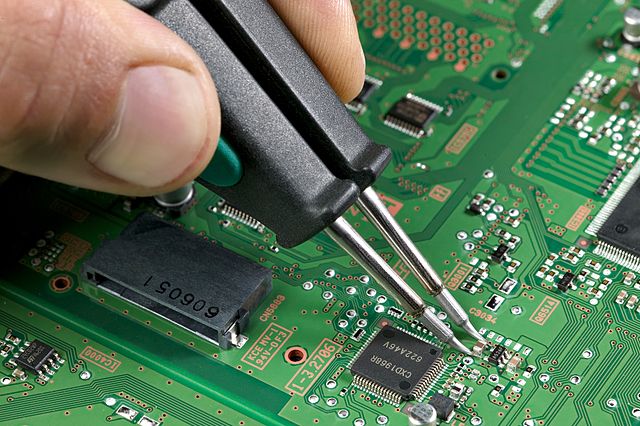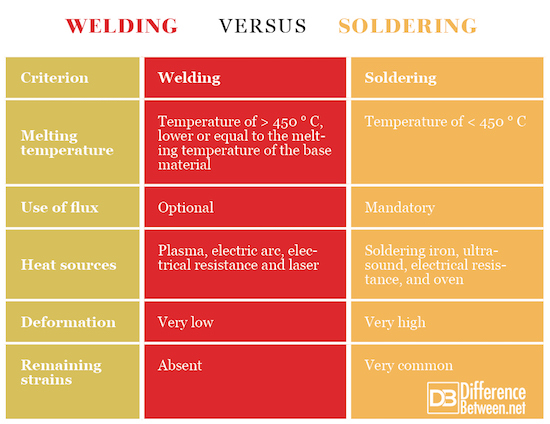Difference Between Welding and Soldering
Welding is the process of joining parts, often of metal, by heating to the degree of melting of touching parts. Unlike welding, which is a heat treatment as well as soldering, soldering is a method of joining predominantly metallic parts using a molten material, with melting temperature below the melting temperature of the base material.
What is Welding?
Welding is the connection of two or more, same or different materials, by melting or pressing, with or without the addition of additional material, in order to obtain a homogeneous welded joint. According to the method of joining the welding methods, they are divided into two large groups:
- Fusion welding, welding of materials in melt state at the joint site, with or without additional material.
- Gas welding
- Electrical welding
- Welding by pressing the welding of the material in a solid or soft state at the joint location by means of pressure or shock.
- Forge welding
- Electro- resistance welding.
Most welding processes were discovered in the 20th century, but some procedures, such as solder welding, have been known in the old age. Welding has evolved as an integral part of the skills of blacksmiths, goldsmiths and lumber makers in the production of tools, weapons, vessels, jewelry and buildings (fences, doors, bridges, hardware, etc.) Welding is a complex process and it is not easy to determine it accurately. The term welding refers to the ability of the material to achieve a continuous welded joint under certain welding conditions, which will meet the conditions and durability of the properties. In addition, the chemical properties of the metal, the dimensions of the parts, the type of additional material, the preparation of the welding joint, are affected by the weldability of some metals.
What is Soldering?
Soldering is defined as the process of joining where the base material joins together using an additional material whose melting temperature does not exceed 450 °C. The base material does not melt during the coupling process. The additional material is usually arranged between the correctly arranged surfaces of the compound by means of capillary. Like hard soldering and other bonding processes, soft soldering involves several fields of science including mechanics, chemistry, and metallurgy. Soldering is a simple operation consisting of the relative positioning of the connecting parts, the wetting of surfaces with molten additional material and allowing the additional material to cool until it is clogged. The connection between the additional and the base material is more than adhesion or mechanical, although they contribute to the strength of the joint. The key feature of the compound is the metallurgical bond between the additional material and the base material. The additional material reacts with the basic material and quasi by the formation of intermetallic compounds. After curing, the joint is held together with the same attractive force that holds a piece of metal together. The numerous methods of heating available for soldering often represent designer or engineer constraints when choosing the best capillary joint. Since effective capillary coupling requires efficient heat transfer from a heat source, it is not possible, for example, to wire a wire of 0.0025 millimeters in diameter to a piece of copper weighing from 2 to 3 kilograms with a small burner. The size and price of individual assemblies, the required number and the speed of production will influence the selection of the heating method. Other factors must also be considered including the heating rate, the differential thermal gradient as well as the external and internal cooling rates. These factors vary greatly in different methods of heating, and their impact on dimensional stability, deformation and the structure of the compound should be considered.
Difference Between Welding and Soldering
-
Melting temperature of additional material
In case of welding the temperature is >450°C, lower or equal to the melting temperature of the base material. Soldering is mechanical process with temperature of <450°C.
-
Use of flux
The use of flux to protect the surface of the base material and to aid wetting of the same in case of welding is optional, but in case of soldering is mandatory.
-
Heat source
Common heat sources when welding are plasma, electric arc, electrical resistance and laser. Heat sources of soldering are soldering iron, ultrasound, electrical resistance, and oven.
-
Deformation
Probability of deformation in soldering is very low, and in case of welding highly likely.
-
Remaining strains
There are no remaining straining in case of soldering, but there is high probability around the welded joint zone.
Welding vs. Soldering: Comparison chart
Summary of Welding vs. Soldering
- Welding is the bonding of two or more, identical or different materials, by melting or pressing, with or without the addition of additional material, in order to obtain a homogeneous welded joint. According to the method of connecting, welding can be divided into two large groups: Welding by melting, welding of materials in the molten state at the point of the compound, with or without material and welding by pressing, welding of the material in solid or softened condition on the joint with pressure or impact.
- Soldering is a process by which metallic or non-metallic parts are merged with molten material into an inseparable whole. The base material is soldered because it has more melting point than the additional material. Better soldering results can be achieved by using a “pelletizer” (powder, paste, solution) and / or a protective atmosphere (gas or vacuum) in which soldering is performed.
- Difference Between Thermodynamics and Kinetics - June 24, 2018
- Difference Between Welding and Soldering - June 24, 2018
- Difference Between Additive Colors and Subtractive Colors - June 20, 2018
Search DifferenceBetween.net :
Leave a Response
References :
[0]Image credit: https://upload.wikimedia.org/wikipedia/commons/thumb/a/aa/GMAW.welding.af.ncs.jpg/680px-GMAW.welding.af.ncs.jpg
[1]Image credit: https://upload.wikimedia.org/wikipedia/commons/thumb/f/f8/Soldering_a_0805.jpg/640px-Soldering_a_0805.jpg
[2]American Welding Society. “Brazing handbook”, Fourth Edition, Miami: American Welding Society, 1991.
[3]ASM International. “ASM Handbook Volume 6: Welding, Brazing and Soldering”, Ohio: ASM International, 1993.
[4]Fenton E. A. “Soldering Manual”, Miami: American Welding Society, 1959.



